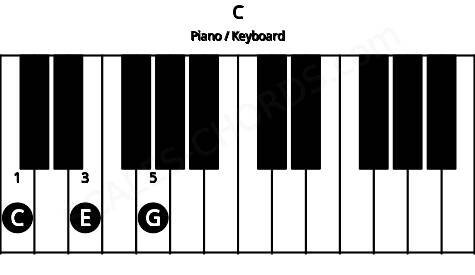The C chord piano is one of the most essential and fundamental chords for beginners learning to play the piano. Whether you’re just starting out or looking to enhance your skills, mastering the C chord is crucial for playing a variety of songs. In this guide, we will break down how to play the C chord piano, its components, variations, and common uses in music.

What is the C Chord Piano?
The C chord piano is a major chord made up of three notes: C, E, and G. When played together, these notes create a bright, happy sound that is characteristic of a major chord. The C chord piano is the foundation of the C major scale and serves as one of the most used chords in many music genres, from pop to classical.
Components of the C Chord Piano
To fully understand the C chord piano, it’s important to know its three main components:
- C – This is the root note of the chord, establishing the key of C major.
- E – The major third, which contributes to the chord’s bright and uplifting sound.
- G – The perfect fifth, which provides stability and balance to the chord.
When you press the C chord piano with these three notes, you’ll hear a full and harmonious sound that forms the base of many musical compositions.

How to Play the C Chord Piano
Learning how to play the C chord piano is simple and perfect for beginners. Here’s a step-by-step guide:
- Find the C Key – The C key is located immediately to the left of the two black keys on the piano.
- Place Your Thumb on C – Use your right-hand thumb to press the C key.
- Place Your Middle Finger on E – Next, place your middle finger (3rd finger) on the E key.
- Place Your Pinky on G – Finally, press the G key with your pinky finger (5th finger).
Tips for Playing the C Chord Piano
- Start slowly and practice the finger placements until you feel comfortable.
- Make sure all notes are played clearly for a clean sound.
- Once you’ve mastered the C chord piano, try experimenting with other basic chords like F and G for practice.
Variations of the C Chord Piano
While the basic C chord piano consists of C, E, and G, there are several variations you can explore:
C Major 7 (Cmaj7)
The Cmaj7 chord adds the B note, resulting in the notes C, E, G, and B. This variation gives the chord a richer, more sophisticated sound.
C Minor (Cm)
The Cm chord replaces E with E♭, creating a sadder, more melancholic tone. The notes for this variation are C, E♭, and G.
C Suspended 4 (Csus4)
The Csus4 chord replaces E with F, creating an open and unresolved sound. The notes for this chord are C, F, and G.
C Power Chord (C5)
The C5 chord omits the E note, consisting of only the root (C) and the fifth (G). It’s commonly used in rock and pop music for a more basic, bold sound.
Common Uses of the C Chord Piano
The C chord piano is a staple in many genres of music. Here are some common ways it is used:
- In Pop and Rock Music: The C chord piano is featured in countless songs. Famous tracks like “Let It Be” by The Beatles and “Someone Like You” by Adele use this chord prominently.
- In Classical Music: The C chord piano serves as the tonic chord in many classical compositions, establishing the key of C major.
- In Jazz and Blues: While jazz and blues often use more complex chords, the C chord piano remains foundational in many chord progressions.
Conclusion
Mastering the C chord piano is essential for every pianist, whether you’re just beginning or looking to expand your musical knowledge. Understanding its components, learning how to play it, and experimenting with variations will help you unlock a world of musical possibilities. With practice, the C chord piano will become a valuable tool in your musical journey.
By focusing on the C chord piano, you’ll be ready to play countless songs across genres, from classical to modern pop, and create your own compositions with ease. Happy playing!
For further reading : https://en.wikipedia.org/wiki/Piano
For more articles : https://pianopassion.org/




Leave a Reply